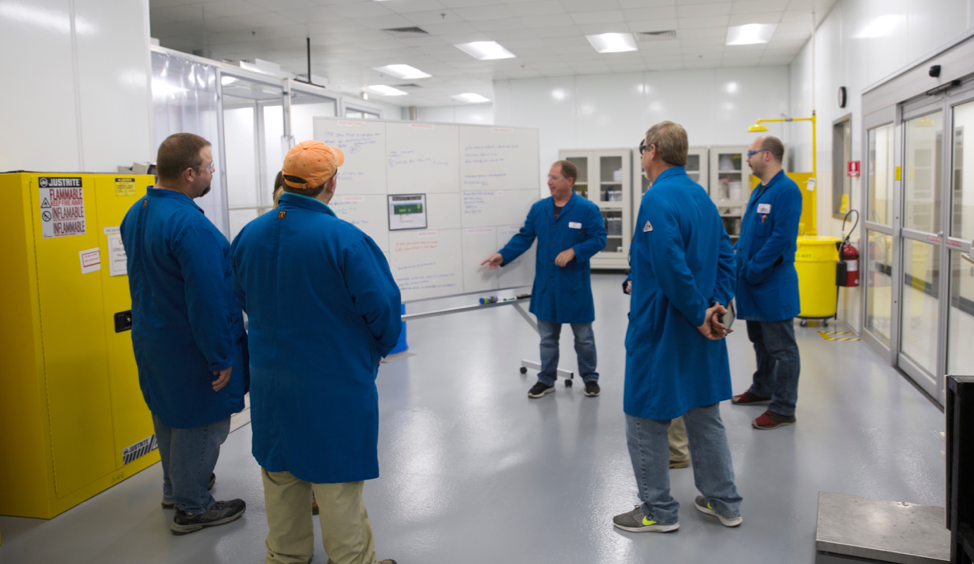Remember WWII’s Rosie the Riveter, the strong and capable figure symbolizing real-life women who took over factory work for men fighting overseas?
Manufacturers are wishing Rosie would make a comeback — and this time they’d like her to vie for a leadership position as well.
Though women now make up about 47 percent of the workforce in the U.S., women continue to be far underrepresented in the manufacturing world, making up only 27 percent of that workforce. That’s true in nearly every part of manufacturing, reported a Manufacturing Institute study last year — particularly at the leadership level.
That’s of particular concern because of projected worker shortages; leaders expect to have to fill 3.5 million manufacturing jobs by 2025 due to economic expansion and retirement of baby boomers, and some 2 million of those jobs are set to require specific skills. In fact, retention and engagement of employees of all genders is already considered the number-one problem faced by employers across the board thanks to shifting attitudes about work, increasing demand for work-life balance and a more transparent job market.
In other cases, women innately bring extra value to an organization. A lack of corporate diversity can leave firms more vulnerable to employment-related litigation and turnover among minority employees. Additionally, greater diversity statistically leads to better corporate financial performance and higher stock market valuations, the study reports, in part because it lends itself to more “out-of-the-box” ideas. Further, when women are teamed with men, the teams boost their “collective intelligence” or general effectiveness because the women are more attuned than men to others’ nonverbal cues, feelings and thoughts.
All that is causing analysts to view women as a major untapped resource for tomorrow’s manufacturing.
“The good news is, many manufacturers are turning the tables and making a more concerted effort to get women on board,” reads the report. “Manufacturers can’t afford to just dip a toe in a talent pool where greater numbers of educated women than men are swimming, nor can they wade forward. It’s time to dive into the deep end in an attempt to close the gender gap.”
What’s going on?
When it comes to recruiting women, the manufacturing segment may be hampered by the following:
- Lack of exposure to manufacturing environments. The study found Generation Y women (born between 1977 and 1994) are particularly unlikely to choose manufacturing as their first career choice. Conversely, 64 percent of those who have worked in such environments (or know someone who has) agreed they are “interesting and rewarding” to work in.
- A reported lack of interest in products traditionally associated with manufacturing, such as industrial products, chemicals and automotive parts/vehicles.
- Few female co-workers already on the job.
- Prevailing myths about careers in manufacturing, including:
- Manufacturing pay is low. In actuality, hourly compensation is 17 percent higher in manufacturing in other industries, and the average U.S. manufacturing worker was earning $20.46/hour in July.
- Manufacturing jobs are unskilled. Today’s workforce is actually involved in everything from robotics to chemistry to laser technology, and many jobs require significant skill.
- Manufacturing provides few opportunities for advancement. On the contrary, most employers won’t hire you if you don’t see yourself growing with the company. And many offer educational opportunities.
- Manufacturing jobs are dirty. Not so: most today are clean, safe, controlled for temperature and humidity, and ergonomically optimized to reduce fatigue.
- Most manufacturing is moving overseas. The Washington Post recently wrote about how American productivity is keeping us in the game. “The best American manufacturers customize products to meet customer needs, reduce the time required to make them and constantly improve their design,” it reports.
What can be done?
The Manufacturing Institute study recommends manufacturers consider the following strategies to increase recruiting and retention of female employees:
- Design different recruitment strategies for women (something 65 percent of U.S. companies lack, the study reports).
- Introduce girls to the merits of manufacturing in elementary school, incorporating it into STEM curricula. Related elementary-level programs mentioned in the study include the National Girls Collaborative Project, Dream It. Do It., and Schools2Skills.
- Find ways to enhance the three top job motivators identified by women in the study: Challenging and interesting assignments, attractive pay and work-life balance, respectively.
- Stave off the top issues causing women to leave manufacturing, such as poor working relationships and poor work-life balance. “The onus is on employers to become a ‘simply irresistible organization’, which includes positive working relationships,” the study advises calling the most positive work environments “flexible, humanistic, recognition focused, inclusive and diverse.”
- Avoid any hint of a double standard or lack or promotional opportunities. Two-thirds of survey respondents maintain a double standard exists in manufacturing and three-fourths say women face higher standards than men.
“Part of creating a conducive workplace is cultural,” writes Natalie Schilling in Forbes. “We as manufacturers need to demonstrate we are responsive to the unique work-life challenges that women — especially women who are or who plan to become mothers — face. We may need to allow flexible work schedules or allow women to manage the speed of their careers depending on their responsibilities outside of work. We also need more men to lead the way toward a more diverse and inclusive manufacturing force.”




Subscribe to Our Blog